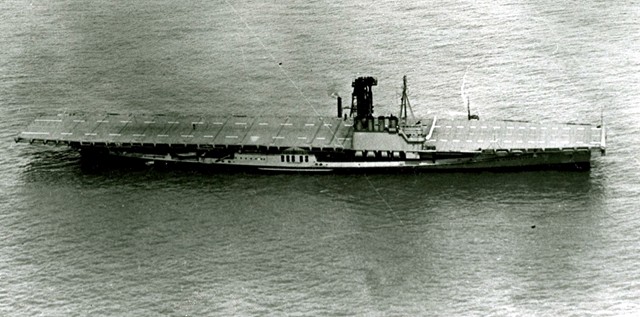May 23, 2010
Wolverine!
War. War never changes. In 1942, war was raging and the US Navy had a problem. It was obvious that the aircraft carrier was going to be the deciding factor in the Pacific, and a major player in the battle for the Atlantic. A gazillion carriers were going to be coming out of the shipyards, and they would need squadrons upon squadrons of planes and pilots to fill their hangars. While there wouldn't be a problem building the planes, the pilots would be another thing altogether. There would be hordes of men wearing the wings, certainly, and they would have plenty of training in how to fly their planes, but naval aviation is a different type of beast... because of the aircraft carrier.
When the Army Air Forces taught a man how to fly, they were able to assure their pilots that, at the end of a mission, they would have a nice long runway (or a well-manicured meadow) to come home to. On the other hand, most Navy pilots would be in training for carrier aviation. This meant they'd have to put their plane down on a small (at least in comparison to AAF runways) flight deck somewhere in the middle of an ocean... that was moving. That's a problem, because you can't simulate that on land. To be sure, you can paint a flight deck on a runway to give an idea of the size. You can put a Landing Signal Officer at the end on the runway to teach a pilot how to follow his instructions. You can even put arresting wires across the runway to give the rookie pilot a taste of the stresses involved with landing on a carrier. But you can't duplicate the rolling and pitching, the winds, the turbulence off the island, and the sense of scale involved (even a big carrier is very, very small in comparison to the ocean).
Prior to the start of WWII, the US Navy trained their neophyte pilots on carrier landings by landing them... on carriers. That sounds obvious and it surely is, but what do you do when it's going to take all of your current CVs just to hold the line... and they're only barely accomplishing that? Throw in the threat of submarines, and even if you had a spare carrier lying around you couldn't operate it in a manner that would make training a rookie pilot easier. Then there's this little problem with rookie pilots (and trained pilots, for that matter), in that they crash. Over and above the tragedy involved, a violent crash could cripple a carrier at a time when every flight deck mattered. But sending a squadron of pilots out to war with practically no experience on landing on a carrier deck is a recipe for disaster.
In March of 1942, the US Navy came up with an answer.
more...
When the Army Air Forces taught a man how to fly, they were able to assure their pilots that, at the end of a mission, they would have a nice long runway (or a well-manicured meadow) to come home to. On the other hand, most Navy pilots would be in training for carrier aviation. This meant they'd have to put their plane down on a small (at least in comparison to AAF runways) flight deck somewhere in the middle of an ocean... that was moving. That's a problem, because you can't simulate that on land. To be sure, you can paint a flight deck on a runway to give an idea of the size. You can put a Landing Signal Officer at the end on the runway to teach a pilot how to follow his instructions. You can even put arresting wires across the runway to give the rookie pilot a taste of the stresses involved with landing on a carrier. But you can't duplicate the rolling and pitching, the winds, the turbulence off the island, and the sense of scale involved (even a big carrier is very, very small in comparison to the ocean).
Prior to the start of WWII, the US Navy trained their neophyte pilots on carrier landings by landing them... on carriers. That sounds obvious and it surely is, but what do you do when it's going to take all of your current CVs just to hold the line... and they're only barely accomplishing that? Throw in the threat of submarines, and even if you had a spare carrier lying around you couldn't operate it in a manner that would make training a rookie pilot easier. Then there's this little problem with rookie pilots (and trained pilots, for that matter), in that they crash. Over and above the tragedy involved, a violent crash could cripple a carrier at a time when every flight deck mattered. But sending a squadron of pilots out to war with practically no experience on landing on a carrier deck is a recipe for disaster.
In March of 1942, the US Navy came up with an answer.
more...
Posted by: Wonderduck at
11:03 PM
| Comments (4)
| Add Comment
Post contains 839 words, total size 6 kb.
May 22, 2010
Name That Ship!
As most of my regular readers know, I have a deep interest in WWII, with an emphasis on the Pacific Theater, and have had for many, many years. For much of that time I've been drawn to the more obscure bits of hardware used by the various armed forces. Everybody knows about the Mustang, the Spitfire or the Flying Fortress, and for good reason. Even the Buffalo is well-known, if for all the wrong reasons. But who champions the little guys, the Vindicators of the world? Or, really, who cares about the nigh-on forgotten things? I do, for I am as fascinated by the "backstage" people as much as the main characters, if not moreso. Heck, a couple of days ago I discovered that there was a floatplane version of the F4F built and tested (charmingly called the "Wildcatfish") and was tickled pink.
So you can only imagine my joy when I first learned about this ship:

Except I'm not going to tell you anything about it. Yet. Instead, I want to see if any of my readers know the name of this surprisingly influential vessel, or if not the name, what you can tell me about her. Leave your guesses in the comments, and no cheating!
So you can only imagine my joy when I first learned about this ship:

Except I'm not going to tell you anything about it. Yet. Instead, I want to see if any of my readers know the name of this surprisingly influential vessel, or if not the name, what you can tell me about her. Leave your guesses in the comments, and no cheating!
Posted by: Wonderduck at
09:35 PM
| Comments (4)
| Add Comment
Post contains 210 words, total size 2 kb.
May 21, 2010
What In The World?
I just don't... huh?

Gaaaaahhhhhhhhhhhhhhhhhhhh...

Posted by: Wonderduck at
03:02 PM
| Comments (5)
| Add Comment
Post contains 9 words, total size 1 kb.
May 18, 2010
*Headtable*

-Sora no Woto, ep01
I'm going to have to admit to being not exactly motivated to blog these days. It just... sort of feels like work at the moment. I've had these feelings in the past, and they usually pass quickly, generally when I stumble over something interesting or I'm distracted by something shiny. For all I know, I'll be back tomorrow... or next Monday, to prepare for the GP of Turkey.
But when Formula 1 is getting to be a chore, and it is, that's when I know I need to take a break, no matter how long it's for.
So sit tight, maybe leave me a comment saying that you can't stand to see me go (*snort*) or wanting a question answered ("Was the Wildcat used throughout WWII?" for example), and I'll come back sooner or later.

-Sora no Woto, ep01
I'm going to have to admit to being not exactly motivated to blog these days. It just... sort of feels like work at the moment. I've had these feelings in the past, and they usually pass quickly, generally when I stumble over something interesting or I'm distracted by something shiny. For all I know, I'll be back tomorrow... or next Monday, to prepare for the GP of Turkey.
But when Formula 1 is getting to be a chore, and it is, that's when I know I need to take a break, no matter how long it's for.
So sit tight, maybe leave me a comment saying that you can't stand to see me go (*snort*) or wanting a question answered ("Was the Wildcat used throughout WWII?" for example), and I'll come back sooner or later.
Posted by: Wonderduck at
07:55 PM
| Comments (9)
| Add Comment
Post contains 140 words, total size 1 kb.
May 12, 2010
I Am Amuse
Nothing important or even pressing to discuss, so here's a picture of Picard with a bucket on his head.

That is all.

That is all.
Posted by: Wonderduck at
10:47 PM
| Comments (1)
| Add Comment
Post contains 25 words, total size 1 kb.
May 11, 2010
Wetdock
According to the Halifax Chronicle Herald, a floating drydock... well, stopped floating this past Saturday. The Scotia Dock II went down in about 50 feet of water as it maneuvered into position to hoist a tugboat inside for repairs.

Once they figure out how to raise the wetdock, they'll be able to figure out just exactly why it went down. I suspect that once they can get down to the bilges, they'll find this:

Oops.

Scotia Dock II in drier times
Geoff Britt, spokesman for the company that owns the Scotia Dock II, refused to say that it sank, instead suggesting that it "dropped below normal operating levels." Underwater for pretty much any ship that isn't a submarine should be considered "below normal operating levels," yes.Once they figure out how to raise the wetdock, they'll be able to figure out just exactly why it went down. I suspect that once they can get down to the bilges, they'll find this:

Oops.
Posted by: Wonderduck at
06:07 PM
| Comments (3)
| Add Comment
Post contains 127 words, total size 1 kb.
<< Page 1 of 1 >>
45kb generated in CPU 0.0238, elapsed 0.3276 seconds.
50 queries taking 0.3148 seconds, 309 records returned.
Powered by Minx 1.1.6c-pink.
50 queries taking 0.3148 seconds, 309 records returned.
Powered by Minx 1.1.6c-pink.









